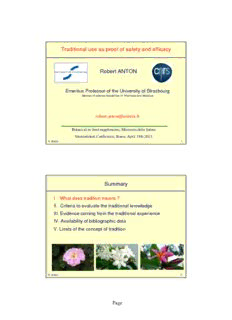
Traditional use as proof of safety and efficacy Robert ANTON Summary PDF
Preview Traditional use as proof of safety and efficacy Robert ANTON Summary
Traditional use as proof of safety and efficacy Robert ANTON Emeritus Professor of the University of Strasbourg Member of national Academies of Pharmacy and Medicine [email protected] Botanical in food supplements, Ministero della Salute International Conference, Rome, April 18th 2013 R. Anton 1 Summary I. What does tradition means ? II. Criteria to evaluate the traditional knowledge III. Evidence coming from the traditional experience IV. Availability of bibliographic data V. Limits of the concept of tradition R. Anton 2 Page 1. A long history of use and the modern science Young girl Papoue from New Guinea (Photo A. Newman) R. Anton 3 2. Many traditional food supplements and drugs used in all the world R. Anton 4 Page 3. The traditionI .is aI precious guide Materia medica: compendium of real clinical observations: China, Guyana, India, Madagascar, New Caledonia… R. Anton 5 4. A proof of efficacy: history of use and modern science XVI e century: clinical trial of aerial parts of spirea (Spirea ulmaria, Rosaceae) antipyretic salicylic aldehyde glycoside Hippocrates 500 b.c. (Salix alba, Salicaceae), bark antalgic salicylic alcohol glycoside R. Anton 6 Page 4. A proof of efficacy: History of use and modern science Gerhardt : acetylation of salicylic acid (1853) Anti-inflammatory- antirheumatic (prostagladines) (1971) Platelets aggregation inhibition (1985) Colon cancer prevention (1997) COOH COOH OH hémisynthèse OCOCH 3 métabolisme salicylic acid acetylsalicylic acid (aspirin) R. Anton 7 5. Ethical drugs and molecular models Artemisia (artemisinine), Belladonna (atropine),Camptotheca (camptothecine), Catharanthus (vinblastine), Cinchona (quinine),Coca (cocaine), Colchicum (colchicine), Digitalis (digoxine), Ephedra (ephedrine),Ipeca (emetine), Ochrosia (ellipticine),Papaver (morphine, codeine)… Taxus baccata Diterpene: Taxol Commercial drug R. Anton 8 Page 6. Ambivalent or borderline plants for food supplements Cytisus Cynara Spirea Gentiana Passiflora Ficaria Mélilotus R. Anton 9 Summary I. What does tradition means? II. Criteria to evaluate the traditional knowledge III. Evidence coming from the traditional experience IV. Availablity of bibliographic data V. Limits of the concept of tradition R. Anton 10 Page 1. Parameters to take into consideration on traditional information Long history of use (generally many centuries) Collection of all information on practical traditional use Existence of convergence of use in different continents without primitive contact R. Anton 11 Examples: Convergence of uses in different continents Example of chinese Panax ginseng C.A. Meyer: adaptogene helping to cope with mental and physical stress. The canadian or american Panax quinquefolius L.: same chemical profile (ginsenosides), similar conditions of use Plantago sp. growing in separate regions in the world and used for the same type of symptoms: relative respiratory discomfort. R. Anton 12 Page 1. Parameters to take into consideration on traditional information Rigourous botanical identification Chemotaxonomic aspects Geographical origin and cultivation methods Part of the plant used Respect of the traditional type of preparation Identification of the type of population concerned Observation on eventual secondary effects Confirmation state with chemical profile in order to understand the pharmaco-clinical effects R. Anton 13 2. Rigourous identification of raw material Importance of the complete scientific denomination Example of family, genus and species Lamiaceae family Lavandula angustifolia Mill., Lavandula latifolia Medik. … Example of sub species and varieties: Bergamot (Citrus aurantium L. sspbergamia(Wight & Arnott) Engler) Bitter orange(Citrus aurantiumsspaurantiumL.) Example of varieties with different compositions: Basilicum (Ocimum basilicum): heterogenicity in terms of morphologies and chemical profiles (O. basilicumvar. basilicum, O. basilicumvar. difformeBenth., O. basilicumvar glabratumBenth….) R. Anton 14 I Page 3. Importance of the plant chemotypes Accuracy of chemotypes Examples - Thymus vulgaris with linalol - Thymus vulgaris with geraniol - Thymus vulgaris with thujanol - Thymus vulgaris with thymol - Thymus vulgaris with carvacrol - Thymus vulgaris with terpineol - Thymus vulgaris with p-myrcene - consequence: different chemical profiles and toxicity R. Anton 15 4. Importance of the chemotaxonomy Aristolochiaceae: all species contain toxic aristolochic acid Other plant species from other palnt families also contain diverse aristolochic acids and aristolactames Forbidden: severe renal and hepatotoxicity (oral route) Aristolochic acid R. Anton 16 Page 5. Importance of data for production of the raw material Geographical origin and multiple extrinsic factors: influence on the secundary metabolism - environment and growing conditions - mode of cultivation or wild state - temperature, humidity, sunny period - harvesting time ….additional treatments R. Anton 17 6. Importance of the part of the tarditional plant used Type of organs: differenciation concerning the same species Example of Cinnamomum zeylanicum Bark of Leaves and young stems young branches eugenol cinnamic aldehyde R. Anton 18 Page 7. Traditional forms of botanical preparations Aqueous extraction (hot water): infusion, decoction (root, seed), maceration (cold water for mucilages) Dried aqueous forms Hydro-alcoholic extracts: advantages: extraction of both lipophilic and hydrophilic constituents; presence of glycosides more physiologically active R. Anton 19 10. Numerous qualitative and quantitative analytical techniques: Ginkgo extract: HPLC-TLC… - R. Anton 20 Page
Description: